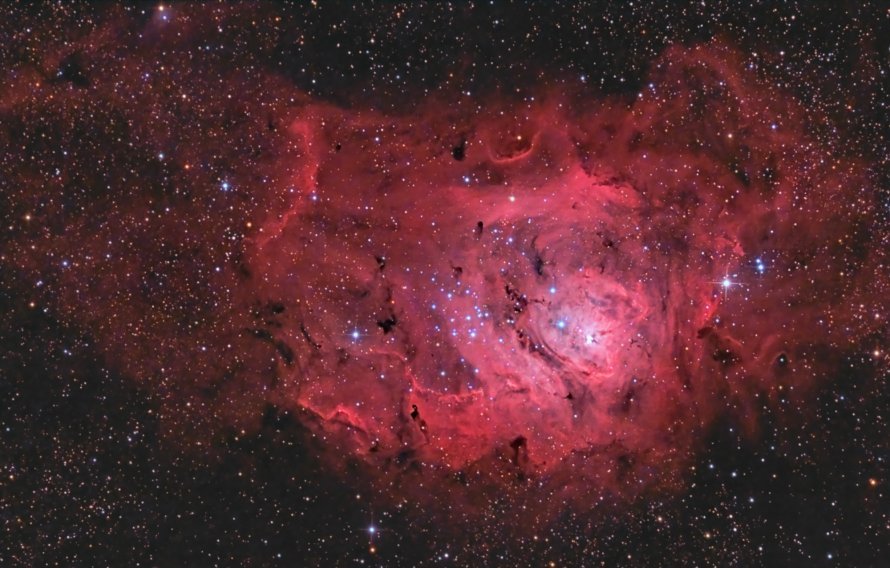M8 (NGC 6523) - Lagoon Nebula
Messier 8 (NGC 6523), also known as the Lagoon Nebula, is a nebula w/cluster located in the constellation Sagittarius, in the Sagittarius Arm of the Milky Way Galaxy in the Local Group of galaxies. M8 is 4000 light years away from Earth.
M8 is best viewed during late summer, is magnitude 6, and can be viewed with naked eye (barely). M8 is 2.5° x 40' in apparent size. For reference, the full moon is 30'.
Observing difficulty: Easy
- Name:
- Lagoon Nebula
- Type:
- nebula w/cluster
- Constellation:
- Sagittarius
- NGC or IC:
- NGC 6523
- Magnitude:
- 6
- Viewing:
- naked eye (barely)
- Size:
- 2.5° x 40'
- Distance (light years):
- 4000 LY
- RA:
- 18h 3.1m
- Dec:
- -24 23'
- Season:
- late summer
- Milky Way location:
- Sagittarius Arm
- Galaxy group:
- Local Group
- Messier Marathon #:
- 98
- Contains:
- Hourglass Nebula
* The naked eye can see up to magnitude ~7-8 objects under ideal dark sky conditions.
Unveiling the Lagoon Nebula
Located in the heart of the Milky Way, Messier 8 (M8), more commonly known as the Lagoon Nebula, is a captivating mix of a diffuse nebula, an emission nebula, and an open star cluster. This celestial object offers astronomers a profound opportunity to understand stellar birth and the interplay between newborn stars and their natal clouds. This article delves into a comprehensive, technical exploration of M8, touching on its discovery, physical properties, stellar population, and scientific significance.
Discovery and Observation
Messier 8 was first observed by Italian astronomer Giovanni Hodierna before 1654 and later cataloged by Charles Messier in 1764. Located approximately 4,100 light-years away in the constellation Sagittarius, M8 is one of the few star-forming regions visible to the naked eye from Earth, with its most luminous regions and associated star cluster, NGC 6530, easily visible with binoculars or a small telescope.
Physical Characteristics
Encompassing a space nearly 110 by 50 light-years, M8 is a substantial interstellar cloud composed primarily of hydrogen gas, mixed with traces of dust and other elements. It is characterized by its reddish emission nebula, its blue reflection nebula, and dark nebulae patches. The most remarkable feature, known as the "Hourglass Nebula," resides in the core of M8 and is illuminated by the young, hot star Herschel 36.
Stellar Composition
Embedded within the Lagoon Nebula is the open star cluster NGC 6530, comprising about 50 to 100 stars. This cluster, with an estimated age of just 1 to 2 million years, is exceptionally young. Many of its stars are massive and hot, most notably the cluster's brightest member, 9 Sagittarii, and the aforementioned Herschel 36, both significantly contributing to the ionization of the surrounding gas.
Star Formation and Protostars
The Lagoon Nebula is an active star-forming region, with protostars in various evolutionary stages. The interplay of intense stellar winds and radiation from the newly formed stars creates a dynamic environment, causing the surrounding gas to glow while also carving out cavities and shaping the nebula. Observations of these phenomena allow astronomers to gain insights into the complex processes of star formation and early stellar evolution.
Scientific Significance
M8 serves as an excellent astronomical laboratory due to its active star formation, relative proximity, and the diversity of its stellar population. Studies of the Lagoon Nebula can provide insights into the lifecycles of stars, the properties and behavior of interstellar medium, and the structure of our galaxy. Furthermore, the nebula's visibility across a wide range of wavelengths, including radio, infrared, visible, and X-ray, makes it a valuable target for multi-wavelength astronomy.
Apparent Magnitude and Distance
The Lagoon Nebula has an apparent magnitude of approximately 6.0, making it faintly visible to the naked eye under ideal dark-sky conditions. The nebula's relatively bright magnitude for a diffuse nebula is due to its size, the number of stars it contains, and its relative proximity to Earth. The nebula is approximately 4,100 light-years away from us.
Finding and Observing Messier 8
The Lagoon Nebula is located in the rich star fields of the Sagittarius constellation, making it relatively easy to find. The nebula can be spotted near the "teapot" asterism of Sagittarius. For observers in the Northern Hemisphere, it is best seen during the summer months when Sagittarius is high in the sky.
Under a dark sky, M8 can be seen with the naked eye as a faint smudge of light. Binoculars or a small telescope will show more detail, revealing the nebula's characteristic lagoon-shaped dust lane. Larger telescopes under darker skies can reveal the intricate details within the nebula, including areas of darker nebulosity and the young star cluster within.



